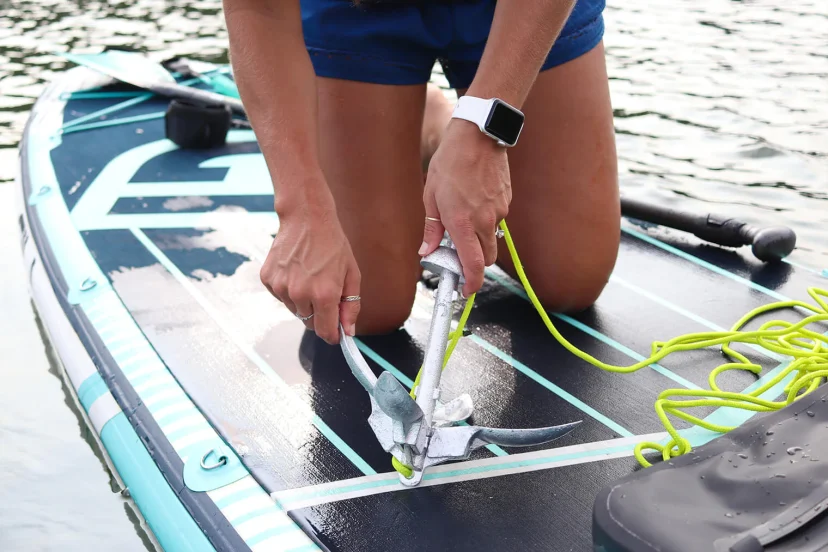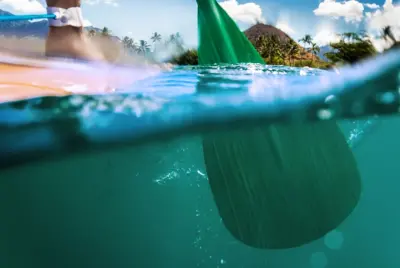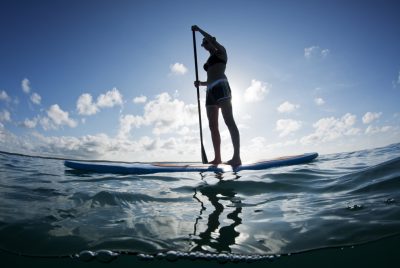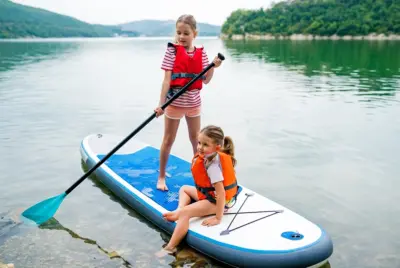Paddle Board Anchor Essentials: Your Guide to Anchoring the Right Way
We may earn a commission for purchases made using our links. Please see our disclosure to learn more.
Greetings, water-lovers! Ever found the perfect spot while paddle boarding but couldn’t stay put because of the current or wind? Enter the paddle board anchor, your solution to staying steady on the water!
Understanding Paddle Board Anchors
A paddle board anchor is a nifty device that helps you to maintain your position on the water. Think of it as your personal parking brake for your paddle board!
The Necessity of a Paddle Board Anchor
Picture this, you’re trying to perfect your SUP Yoga pose or fishing while atop your paddle board, and you can’t because you’re drifting off. That’s where the anchor comes in, it keeps you stationary, and voila, no more floating away!
Diving Deeper: Fluke Anchors, Grapnel Anchors, and Mushroom Anchors
Just like ice cream, paddle board anchors come in different flavors. There are fluke anchors, grapnel anchors, and even mushroom anchors. Each has its own pros and cons depending on the water depth and bottom condition.
Fluke Anchors: The Lightweight Powerhouse
Fluke anchors, also known as Danforth anchors, are an excellent choice for paddle boarders. Here’s why – they’re lightweight, compact, and offer superior holding power. Their design includes two flat, sharp ‘flukes’ that dig into the seabed, providing a firm grip that can withstand heavy currents or winds. It’s like having your own personal bodyguard holding you steady on the water. But they’re not suited for rocky or grassy bottoms; fluke anchors are a bit like the city slickers of anchors, they prefer sandy or muddy conditions.
Grapnel Anchors: The Versatile Go-getters
Let’s talk about Grapnel anchors now. They are the Swiss Army knife of anchors! Compact, robust, and highly versatile, these anchors come with several ‘prongs’ or ‘flukes’ (usually four) that allow them to grip various bottom conditions reasonably well. So, whether it’s a rocky, sandy, or coral bottom, a Grapnel anchor is up for the task. Its ability to fold makes it highly portable. Imagine a Transformer, but instead of turning into a car, it morphs into a compact, easy-to-carry anchor. However, they’re not the best for strong currents or heavy winds as their holding power isn’t as high as fluke anchors.
Mushroom Anchors: The Gentle Giants
Finally, we have Mushroom anchors. These anchors, shaped like a mushroom, hence the name, are designed for soft, muddy bottoms where they can create a suction effect for a firm hold. It’s like the anchor version of a vacuum cleaner, sticking firmly to the mud. However, they are often heavier than fluke and grapnel anchors and might not be the best choice for paddleboards due to their weight and lower holding power in other types of bottoms. They are gentle giants, perfect for conditions that suit them, but a bit overkill for your average paddle boarding day.
Navigating Choices: Choosing the Right Anchor for Your Paddle Board
Choosing the right anchor for your paddle board is akin to choosing a loyal companion for your aquatic adventures. It’s not just about buying the first one you see; you have to consider a few factors.
First, the type of anchor: As we discussed, there are fluke anchors, grapnel anchors, and mushroom anchors, each suited for different bottom conditions. Assess the areas you frequent and make your choice accordingly.
Second, the weight of the anchor: You need something sturdy enough to hold your board in place but light enough for you to carry easily. Usually, anchors between 3 to 5 pounds work well for paddle boards.
Lastly, consider the material of the anchor: Those made from galvanized steel or rust-resistant compounds are durable and less prone to corrosion. Remember, your anchor is not just a tool, but a vital piece of equipment that ensures a safe and enjoyable paddle boarding experience. So take your time, do your research, and choose wisely!
How to Use a Paddle Board Anchor
Anchoring your paddle board isn’t a difficult task, but it does require a bit of understanding and finesse. Let’s walk through the steps.
Step 1: The Anchor Setup
Before you hit the water, ensure your anchor is ready for action. Attach one end of your rope to the anchor. The other end should be secured to your paddle board, usually through a D-ring or handle. Ensure the rope’s length is sufficient for the depth of the water where you’ll be paddle boarding.
Step 2: The Launch
Once you’re at your preferred spot on the water, it’s time to launch the anchor. Hold the rope near the end attached to your board and gently lower the anchor into the water. Make sure you don’t just toss it overboard, as this could scare any aquatic life in the area or, worse, damage your board.
Step 3: Setting the Anchor
Let the anchor hit the bottom. Release more rope to create slack. The rule of thumb for anchor ropes is a 7:1 ratio. That means for every foot of water depth, you should have seven feet of rope. This allows the anchor to lay flat and dig into the seabed effectively. Once the rope is out, tug on it gently to ensure the anchor has set. If you feel resistance, it means your anchor is secure.
Step 4: Securing Your Position
Once the anchor is set, secure the rope to your board, leaving enough slack for small shifts but not so much that you drift away. Some paddle boarders prefer to use a cleat to secure their rope, while others may tie it directly to a D-ring or handle.
Step 5: Return to Shore
When it’s time to head back, gently pull up the anchor, ensuring you don’t disturb the waterbed too much. Rinse the anchor with freshwater after each use to prevent rust or corrosion.
Safety First: Safety Measures When Using Paddle Board Anchors
Adopting safety measures when using paddle board anchors is as crucial as having the right anchor itself. So, let’s dive into some of the critical safety practices to bear in mind.
Wear a Personal Flotation Device (PFD)
Even if you’re an expert swimmer, always wear a PFD. It’s not just a safety regulation in many areas, but it’s also a smart move. If for any reason you fall off your board or get swept by a current, a PFD can be a lifesaver.
Understand Your Environment
Study the body of water you’ll be paddle boarding in. Knowing the depth, the current, the tides, the water traffic, and the seabed composition helps you make informed decisions about when and where to anchor.
Use an Appropriate Length of Rope
Ensure the rope is long enough for the depth of the water, maintaining a 7:1 ratio between the rope length and the water’s depth. This helps the anchor secure itself correctly.
Anchor in Safe Locations
Avoid anchoring in high traffic areas where you could pose a hazard to other water users. Also, be mindful not to anchor in environmentally sensitive areas where you could damage marine ecosystems.
Regular Inspection and Maintenance
Regularly check your anchor and its rope for any signs of wear and tear. A faulty anchor can lead to accidents, especially in rough weather conditions.
Avoid Anchoring in Stormy Weather
If the weather turns stormy or the currents are particularly strong, it may be best not to anchor at all. In such conditions, the anchor might not hold, and managing the board can become difficult.
Learn Basic Knots
Knowing how to tie a few basic knots could make a significant difference, especially if your anchor rope comes loose.
Remember, being on the water is about enjoyment, but it’s also about responsibility – to yourself, to others, and to the environment. Stay safe and anchor smartly!
Maintaining Your Paddle Board Anchor
While an anchor may not be the first thing that comes to mind when you think about SUP equipment, it’s a crucial tool. Anchoring your paddle board ensures it remains stable and doesn’t drift, which can be a lifesaver – quite literally – in more ways than one. But to make sure your anchor serves its purpose and lasts, it’s important to maintain it properly.
Regular Cleaning: One of the easiest ways to prolong the life of your anchor is by cleaning it after each use. Rinse it with fresh water to remove salt, sand, and any potential corrosive materials. This simple habit can significantly reduce the chances of rust and other wear and tear.
Proper Storage: Store your anchor in a dry place away from direct sunlight. Excessive heat and UV rays can damage the rope over time. It’s also essential to make sure your anchor is completely dry before storing it to prevent rust and mildew.
Checking for Wear and Tear: Before and after each use, give your anchor a quick once-over to check for any signs of damage. Pay attention to the rope and the joints – these are typically the first places to show wear.
Replacing Damaged Parts: If you notice any damaged or worn-out parts, replace them as soon as possible. Don’t try to make do with a frayed rope or a rusty anchor. Not only could this damage your paddle board, but it could also pose a safety risk.
Periodic Lubrication: Lubricating moving parts of your anchor with a water-resistant product can help prevent rust and keep the anchor functioning smoothly.
Conclusion
In conclusion, the humble paddle board anchor is a real game-changer. It adds stability, versatility, and, most importantly, the freedom to enjoy your time on the water just the way you like it.
Frequently Asked Questions (FAQs) About Paddle Board Anchors
1. What kind of anchor do I need for my paddle board?
It depends on your paddle board and the type of water body you’re in. Generally, a lightweight fluke or grapnel anchor works well.
2. How do I attach an anchor to my paddle board?
Most anchors come with a line that you can secure to your board using a D-ring or handle.
3. Is using a paddle board anchor safe?
Yes, as long as you follow the safety guidelines, such as wearing a PFD and not anchoring in high traffic or fast-moving waters.
4. How much does a paddle board anchor weigh?
Most anchors for paddle boards weigh between 3 to 5 pounds, which is light enough to carry but heavy enough to hold the board in place.
5. Can I use a paddle board anchor for SUP yoga?
Absolutely, an anchor is perfect for SUP Yoga as it will keep you stationary as you transition through your poses.




